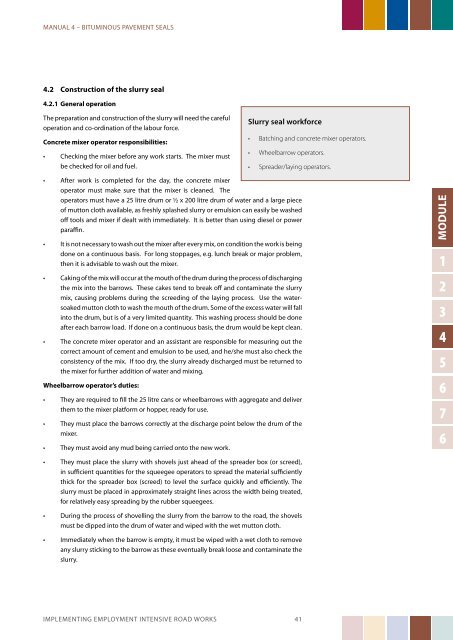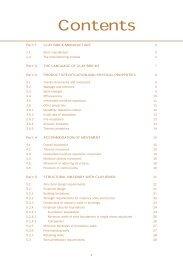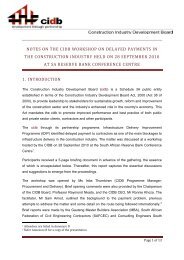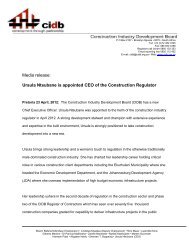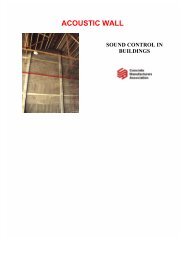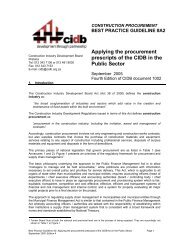MANUAL 4 - Construction Industry Development Board
MANUAL 4 - Construction Industry Development Board
MANUAL 4 - Construction Industry Development Board
You also want an ePaper? Increase the reach of your titles
YUMPU automatically turns print PDFs into web optimized ePapers that Google loves.
<strong>MANUAL</strong> 4 – BITUMINOUS PAVEMENT SEALS<br />
4.2 <strong>Construction</strong> of the slurry seal<br />
4.2.1 General operation<br />
The preparation and construction of the slurry will need the careful<br />
operation and co-ordination of the labour force.<br />
Concrete mixer operator responsibilities:<br />
• Checking the mixer before any work starts. The mixer must<br />
be checked for oil and fuel.<br />
• After work is completed for the day, the concrete mixer<br />
operator must make sure that the mixer is cleaned. The<br />
operators must have a 25 litre drum or ½ x 200 litre drum of water and a large piece<br />
of mutton cloth available, as freshly splashed slurry or emulsion can easily be washed<br />
off tools and mixer if dealt with immediately. It is better than using diesel or power<br />
paraffin.<br />
• It is not necessary to wash out the mixer after every mix, on condition the work is being<br />
done on a continuous basis. For long stoppages, e.g. lunch break or major problem,<br />
then it is advisable to wash out the mixer.<br />
• Caking of the mix will occur at the mouth of the drum during the process of discharging<br />
the mix into the barrows. These cakes tend to break off and contaminate the slurry<br />
mix, causing problems during the screeding of the laying process. Use the watersoaked<br />
mutton cloth to wash the mouth of the drum. Some of the excess water will fall<br />
into the drum, but is of a very limited quantity. This washing process should be done<br />
after each barrow load. If done on a continuous basis, the drum would be kept clean.<br />
• The concrete mixer operator and an assistant are responsible for measuring out the<br />
correct amount of cement and emulsion to be used, and he/she must also check the<br />
consistency of the mix. If too dry, the slurry already discharged must be returned to<br />
the mixer for further addition of water and mixing.<br />
Wheelbarrow operator’s duties:<br />
• They are required to fill the 25 litre cans or wheelbarrows with aggregate and deliver<br />
them to the mixer platform or hopper, ready for use.<br />
• They must place the barrows correctly at the discharge point below the drum of the<br />
mixer.<br />
• They must avoid any mud being carried onto the new work.<br />
Slurry seal workforce<br />
• They must place the slurry with shovels just ahead of the spreader box (or screed),<br />
in sufficient quantities for the squeegee operators to spread the material sufficiently<br />
thick for the spreader box (screed) to level the surface quickly and efficiently. The<br />
slurry must be placed in approximately straight lines across the width being treated,<br />
for relatively easy spreading by the rubber squeegees.<br />
• During the process of shovelling the slurry from the barrow to the road, the shovels<br />
must be dipped into the drum of water and wiped with the wet mutton cloth.<br />
• Immediately when the barrow is empty, it must be wiped with a wet cloth to remove<br />
any slurry sticking to the barrow as these eventually break loose and contaminate the<br />
slurry.<br />
IMPLEMENTING EMPLOYMENT INTENSIVE ROAD WORKS 41<br />
• Batching and concrete mixer operators.<br />
• Wheelbarrow operators.<br />
• Spreader/laying operators.<br />
MODULE<br />
1<br />
2<br />
3<br />
4<br />
5<br />
6<br />
7<br />
6


